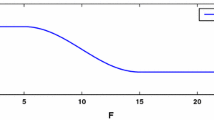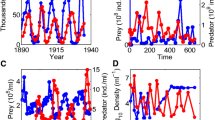Abstract
Several models of rapid switching by a predator in a two-prey environment are analyzed. The goal is to determine how the dynamics of the system and the potential indirect effects between prey are affected by the dependence of switching on total prey density. In exploring this question, the difference between the population-level consequences of switching in stable and cycling predator-prey systems is also examined. We concentrate on reduced switching at low densities, a feature that is likely because of the difficulty of distinguishing between two very low densities. The main findings are: (1) switching in unstable systems can produce positive indirect effects of one prey species on the other; and (2) reduced switching at low densities can greatly alter the dynamics of the system and the indirect effects between prey. Both of the possibilities are only evident in cycling systems. Reduced switching at low total prey densities leads to heavier predation on the slower-growing prey when both prey species are rare. As a consequence, there is a lag in the recovery of the slower-growing prey species after predator densities fall, and the dynamics of the two prey become desynchronized. The net result is increased indirect interactions between prey, and a greater likelihood of exclusion of the slower growing prey. The analysis of these models suggests a need for more empirical work to determine whether switching is reduced by very low total prey densities, and to study the long-term dynamics that occur in systems with switching predators.







Similar content being viewed by others
References
Abrams PA (1987) The functional responses of adaptive consumers of two resources. Theor Popul Biol 32:262–288
Abrams PA (1999) The adaptive dynamics of consumer choice. Am Nat 153:83–97
Abrams PA (2000) The impact of habitat selection on the heterogeneity of resources in varying environments. Ecology 81:2902–2913
Abrams PA (2002) Will declining population sizes warn us of impending extinctions? Am Nat 160:293–305
Abrams PA, Kawecki TJ (1999) Adaptive host choice and the dynamics of parasitoid-host systems. Theor Popul Biol 56:307–324
Abrams PA, Matsuda H (1996) Positive indirect effects between prey species that share predators. Ecology 77:610–616
Abrams PA, Holt RD, Roth JD (1998) Shared predation when populations cycle. Ecology 79:201–212
Baalen M van, Sabelis MW (1999) Nonequilibrium population dynamics of “ideal and free” prey and predators. Am Nat 154:69–88
Baalen M van, Krivan V, van Rijn PCJ, Sabelis MW (2001) Alternative food, switching predators, and the persistence of predator-prey systems. Am Nat 157:512–524
Bergelson JM (1985) A mechanistic interpretation of prey selection by Anax junius larvae (Odonata: Aeschnidae) Ecology 66:1699–1705
Bernstein C, Auger P, Poggiale JC (1999) Predator migration decisions, the ideal free distribution, and predator-prey dynamics. Am Nat 153:267–281
Bonsall MB, Hassell MP (1997) Apparent competition structures ecological assemblages. Nature 388:371–373
Case TJ (1999) An illustrated guide to theoretical ecology. Oxford University Press, Oxford
Comins HN, Hassell MP (1976) Predation in multi-prey communities. J Theor Biol 62:93–114
Cornell H (1976) Search strategies and adaptive significance of switching in some general predators. Am Nat 110:317–320
Ellner S, Turchin P (1995) Chaos in a noisy world: new methods and evidence from time-series analysis. Am Nat 145:343–175
Gendron RP (1987) Models and mechanisms of frequency-dependent predation. Am Nat 130:603–623
Hanski I, Henttonen H, Korpimaki E, Oksanen L, Turchin P (2001) Small rodent dynamics and predation. Ecology 82:1505–1520
Holling CS (1959) The components of predation as revealed by a study of small mammal predation of the European pine sawfly. Can Ent 91:293–320
Holt RD (1977) Predation, apparent competition, and the structure of prey communities. Theor Popul Biol 12:197–229
Holt RD (1983) Optimal foraging and the form of the predator isocline. Am Nat 122:521–541
Holt RD (1984) Spatial heterogeneity, indirect effects, and the coexistence of prey species. Am Nat 124:377–406
Holt RD, Kotler BP (1987) Short-term apparent competition. Am Nat 130:412–430
Hughes RN, Croy MI (1993) An experimental analysis of frequency-dependent predation (switching) in the 15-spined stickleback, Spinachia spinachia. J Anim Ecol 62:341–352
Ims RA (1990) On the adaptive value of reproductive synchrony as a predator-swamping strategy. Am Nat 136:485–498
Joern A (1988) Foraging behavior and switching by the grasshopper sparrow, Ammodramus savannarum, searching for multiple prey in a heterogeneous environment. Am Midl Nat 119:225–234
Kendall BE, Predergast J, Bjørnstad O (1998) The macroecology of population dynamics: taxonomic and biogeographic patterns of population cycles. Ecol Lett 1:160–164
Krivan V (1997) Dynamic ideal free distribution: effects of optimal patch choice on predator-prey dynamics. Am Nat 149:164–178
Lawton, JH, Beddington JR, Bonser R (1974) Switching in invertebrate predators. In: Usher MB, Williamson MH (eds) Ecological stability. Chapman and Hall, London, pp 141–158
Ma BO, Abrams PA, Brassil CE (2003) Dynamic versus instantaneous models of diet choice. Am Nat 162:668–684
Matsuda H (1985) Evolutionarily stable strategies for predator switching. J Theor Biol 115:351–366
Matsuda H, Kawasaki K, Shigesada N, Teramoto E, Ricciardi LM (1987) Evolutionary and ecological stability of prey-predator systems with predatory switching. Lect Notes Biomath 71:172–181
Murdoch WW (1969) Switching in general predators: experiments on prey specificity and stability of prey populations. Ecol Monog 39:335–354
Murdoch WW, Oaten A (1975) Predation and population stability. Adv Ecol Res 9:1–131
Oaten A, Murdoch WW (1975) Switching, functional response, and stability in predator-prey systems. Am Nat 109:299–318
Post, DM, Conners ME, Goldberg DS (2000) Prey preference by a top predator and the stability of linked food chains. Ecology 81:8–14
Rosenzweig ML, MacArthur RH (1963) Graphical representation and stability conditions of predator-prey interactions. Am Nat 97:209–223
Roughgarden J, Feldman M (1974) Species packing and predation pressure. Ecology 56:489–492
Tansky M (1978) Switching effect in prey-predator system. J Theor Biol 70:263–271
Teramoto E, Kawasaki K, Shigesada N (1979) Switching effect of predation on competitive prey species. J Theor Biol 79:303–315
Wickham SA (1995) Trophic relations between cyclopoid copepods and ciliated protists: complex interactions link the microbial and classic food webs. Limnol Oceanogr 40:1173–1181
Acknowledgments
P.A.A. thanks a Strategic Project Grant from the Natural Sciences and Engineering Research Council of Canada and a Fellowship from the J.S. Guggenheim Foundation for financial support. H.M. thanks the Japan Society for the Promotion of Science for financial support.
Author information
Authors and Affiliations
Corresponding author
Rights and permissions
About this article
Cite this article
Abrams, P.A., Matsuda, H. Population dynamical consequences of reduced predator switching at low total prey densities. Popul Ecol 45, 175–185 (2003). https://doi.org/10.1007/s10144-003-0159-3
Received:
Accepted:
Published:
Issue Date:
DOI: https://doi.org/10.1007/s10144-003-0159-3




